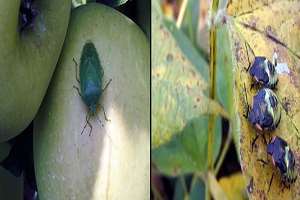During the last four weeks we have observed a very sharp increase in the number of brown marmorated stink bug (BMSB) adults collected in various monitoring traps placed around orchards located in southern Pennsylvania. After relatively lower levels of infestation on fruit observed during the last two seasons, this 2016 harvest seems to bring back a serious BMSB challenge.

Adult brown marmorated stink bug on mature apple. Photo: Greg Krawczyk
We have already received some reports from concerned growers about unacceptable levels of stink bug injuries observed on harvested apples. With some fruit cultivars still four weeks until the harvest, it may be prudent to assess the potential threat from this pest. As the stink bugs are getting ready to enter diapause, their nutritional needs are very high and adult stink bug feeding and consequent damage on fruit can become very significant.

Apple fruit injury by the brown marmorated stink bug feeding—before and after peeling. Photo: Greg Krawczyk
In addition to BMSB feeding, our native stink bugs such as green stink bug are being frequently observed while feeding on mature apple fruit. And while fresh injury on apples are quite difficult to detect, the darkening of flesh and cork spots will be clearly visible within 10-14 days after the stink bug feeding.& Apple fruit injured by stink bugs just before harvest, while they still might look clean at harvest, will develop the characteristic corking symptoms when stored for later consumption.

Green stink bug adult on apple (left) and green stink bug nymphs (right) on soybean foliage. Photo: Greg Krawczyk
Increased numbers of BMSB are also being observed on sites already harvested such as cherry blocks or peaches, which did not see any insecticide applications for a long time, and therefore may as well become the source of late season BMSB invasions. Adult stink bugs in search of food can easily move long distances and colonize orchards which did not observe any problems earlier in the season.
Increased numbers of BMSB are also being observed on sites already harvested such as cherry blocks or peaches, which did not see any insecticide applications for a long time, and therefore may as well become the source of late season BMSB invasions. Adult stink bugs in search of food can easily move long distances and colonize orchards which did not observe any problems earlier in the season.
Since not every orchard will experience the same pressure from BMSB, cautious scouting and monitoring of the vegetation surrounding an orchard should be very helpful in deciding if special stink bug control treatments are necessary.
It is important to remember the absence of stink bugs earlier during the season does not guarantee BMSB and native stink bug species will not become abundant in the orchard around the harvest time.
Commercially available traps and lures for BMSB monitoring provide valuable information and help to decide if insecticide treatments are needed to manage BMSB. Stink bug traps and lures from Ag-Bio and Sterling International are available for purchase and should be very helpful with effective monitoring of BMSB adults and nymphs in orchards. Although stink bug traps, despite catching high numbers of bugs, by themselves will not control BMSB, they can be utilized as the easiest and the most effective warning system for stink bugs presence in orchards.

BMSB commercially available monitoring traps: (Left) Dead-Inn tall pyramid trap; (Right) Rescue stink bug trap with captured brown marmorated stink bugs. Photo: Greg Krawczyk
Source: psu.edu